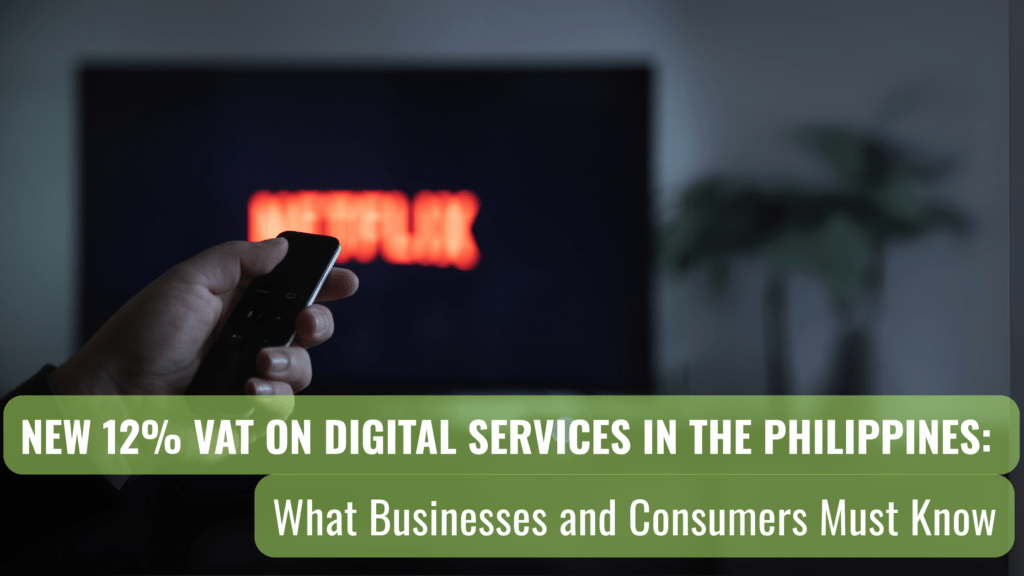The Philippine government’s recently enacted measure to impose a 12% Value-Added Tax (VAT) on digital services is set to reshape the country’s digital economy. With effects beginning as early as June 2, 2025, this new fiscal policy targets both domestic and non-resident providers while aiming to level the playing field between traditional and digital businesses. Below, we combine insights from various industry sources to provide a comprehensive breakdown of this regulation and its impact.
Understanding the Scope of the VAT on Digital Services
Under Republic Act No. 12023 and subsequent regulations, digital services—defined as services supplied online through automated systems—will now incur a 12% VAT. Key points include:
- Coverage of Services:
- Streaming platforms: Services such as Netflix and Spotify will see increased subscription fees.
- Freelance and cloud platforms: Providers like Upwork, along with software subscriptions and cloud storage, must add VAT to their service fees.
- Telemedicine and e-learning: Online consultations and digital education services are also covered.
- E-commerce and digital marketplaces: Online advertising and transactions through digital platforms are subject to this tax.
Digital goods—including digital downloads and subscription-based content—are squarely within the new VAT regimen.
Registration and Compliance Requirements
Both resident and non-resident digital service providers must comply with a series of registration and reporting obligations, as outlined by the Bureau of Internal Revenue (BIR):
- For Non-Resident Digital Service Providers (NRDSPs):
- Registration: NRDSPs must register with the BIR via the Virtual Digital Services (VDS) Portal. Until the portal is fully optimized, registration through the Online Registration and Update System (ORUS) or manual registration at designated Revenue District Offices remains acceptable.
- Filing Procedures: Whether conducting Business-to-Business (B2B) or Business-to-Consumer (B2C) transactions, NRDSPs are required to file VAT returns. For B2B dealings, the Philippine firm using the service countercharges VAT using a reverse charge mechanism, while for B2C transactions, the NRDSP is directly responsible for collecting and remitting VAT.
- Clarifications from the BIR: According to recent announcements (via MSN’s updates and clarifications in RMC No. 47-2025), even NRDSPs engaging exclusively in B2B transactions must file VAT returns. Additional clarifications cover invoicing standards and the proper treatment of transactions via non-resident e-marketplaces. These measures ensure that every taxable digital transaction is reported correctly, minimizing errors and non-compliance.
As per Revenue Regulations (RR) No. 3-2025 and its amendment (RR No. 14-2025), the BIR has also updated deadlines and requirements—including an extended registration deadline for NRDSPs until June 1, 2025.
Accounting Perspective: Key Considerations for Businesses
From an accounting standpoint, the new 12% VAT for digital services brings several considerations:
- Invoicing and Documentation: Providers must issue invoices that clearly indicate the service amount and the separately shown 12% VAT.
- Reporting and Filing: Digital service providers are required to submit quarterly VAT returns using BIR Form 2550-DS. For B2B transactions, VAT withheld by local businesses (using BIR Form No. 1600-VT) can be claimed as input tax credits.
- Impact on Cost Structures:
- For Consumers: The VAT may directly increase subscription fees and service costs, as seen with streaming providers.
- For Freelancers and SMEs: Professionals like freelance graphic designers and digital marketers may face a “tax squeeze” on their operational costs, prompting a closer look at pricing and overhead management.
Account It Right advises that companies review their invoicing systems and accounting software to ensure seamless integration of these changes. Proactive planning, regular audits, and staff training on the new tax rules will be critical to avoid penalties and ensure compliance.
Economic and Social Impacts
While the government defends the measure as a way to correct imbalances in the tax system—ensuring that both traditional and digital businesses contribute their fair share—there are concerns over its regressive nature:
- Criticism and Tax Inequality: Some experts argue that while the VAT levels the playing field for multinational tech companies and domestic giants, the burden will ultimately fall on consumers. Increased subscription costs and fees for digital services may disproportionately affect lower-income groups and freelancers, exacerbating tax inequality.
- Revenue Projections: Projections from various sources indicate that, with a 50% compliance rate, this new digital service VAT could generate billions in revenue—from P7.25 billion this year to an estimated P102.12 billion by 2029. Such figures underline the government’s aim to reinforce the country’s tax base and fund essential public services.
Final Thoughts: Preparing for Change
The implementation of the 12% VAT on digital services marks a significant shift in the regulatory landscape. Whether you’re a non-resident digital service provider or a local business relying on digital subscriptions and tools, the change underscores the need for robust accounting practices and proactive tax planning. At Account It Right, we are committed to helping our clients navigate these regulatory changes with tailored advice and expert support. We recommend that all affected parties begin reviewing their compliance procedures now to ensure a smooth transition.
By staying informed and diligently updating accounting practices, businesses can turn regulatory challenges into opportunities. For further assistance on how to effectively manage these changes, our team at Account It Right is here to help guide you through every step of the process.





